Custom Car Black Wall Tires
CUSTOM CAR BLACK WALL TIRES
During WWII rubber tires were rationed, and white wall tires were not produced at all. This all had huge effects on the looks of this era Custom Cars.
There are a few things that pop up in our head when we think Custom Car… lowered suspension, chopped top, Carson Top, Spotlights, Custom Hubcaps and white wall tires. White wall tires and Custom Cars belong together, it has been like that since the beginning of Customizing, and it still is like that today. But there have been a few year, half a decade that this was not the case. In those years the black wall tired ruled the Custom Car World. Not because it was favorable at the time, not it was because rubber was rationed, and white wall tired were simply not produced for a good number of years.
Lets take a step back first, and have a quick look at the history of the white wall tire.
Officially the first white wall tires were produced by a small tire company in Chicago called Vogue Tyre and Rubber Co. They produced these white wall tires for their horse and chauffeur drawn carriages back in 1914. Early automobile tires were made of pure natural rubber with various chemicals mixed into the tread compounds to make them wear better. The best of these compounds was zinc oxide, a pure white substance that increased traction and also made the entire tire white.
However, the white rubber did not offer sufficient endurance, so carbon black was added to the rubber to greatly increase tread life. In the beginning the “expensive” carbon black was used only in the tread section of the tired. The inner and outer sidewalls where created out of white rubber. The next version of the tires were entirely black, however only the surface of the side walls was covered with a thin, black colored layer of rubber. The black side walls could easily be damaged revealing the white rubber underneath.
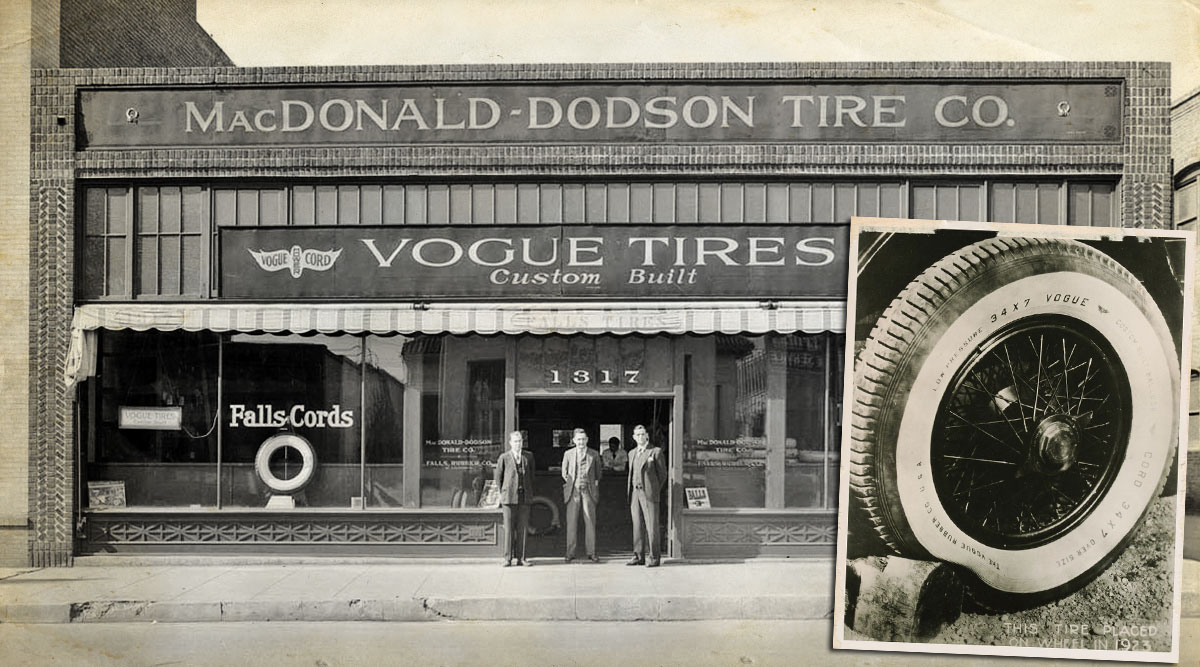 Early picture of the Vogue Tire shop and an 1923 Vogue white wall tire. The inventors of the white wall tire.
Early picture of the Vogue Tire shop and an 1923 Vogue white wall tire. The inventors of the white wall tire.
[divider]
In the early days of the rubber tires the all black tires were more costly, since they required more carbon black to produce. The black wall tire became the higher desired tire, and the more expensive cars in the 1920 were mostly outfitted with black wall tires. When car design became more and more important people started to notice the wonderful contrast of the white wall tire with the black surround set off against shiny painted fenders. From then on the white wall tires were considered to be more stylish and exclusive, and their popularity increased. FoMoCo introduced the white wall tires as an option on all their cars in 1934, and would a few year later even offer a double sided white wall tire as an option.
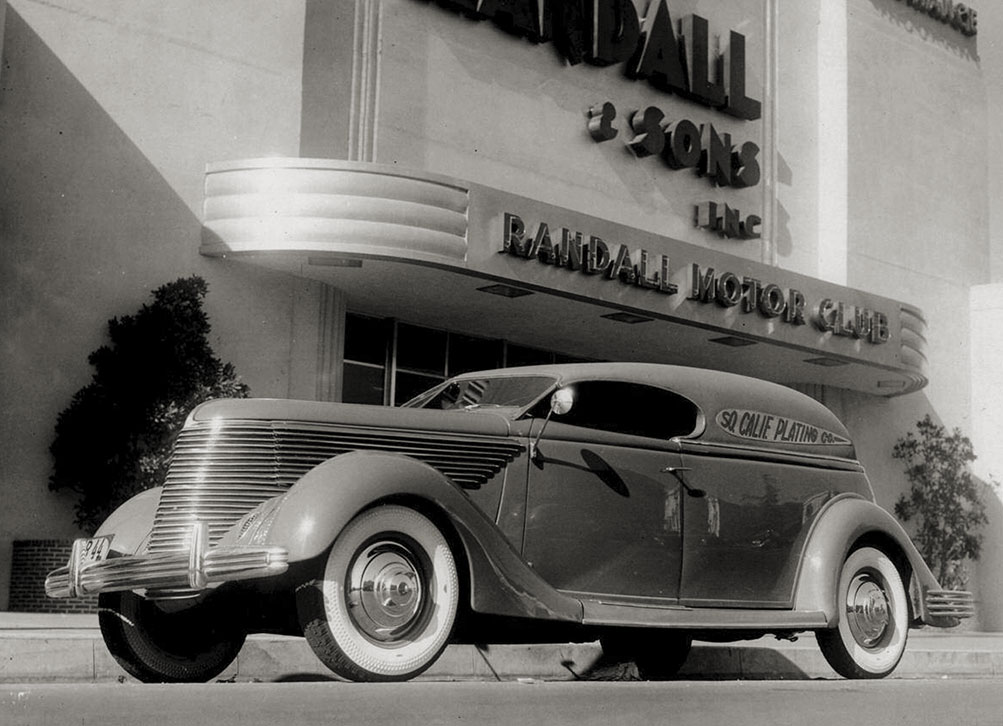 The So Calif Plating Co ’35 Ford shop car is a great sample of the use of wide white walls on early custom. Designed and built in lat e1935, early 1936. The car was outfitted with beautiful Vogue white wall tires.
The So Calif Plating Co ’35 Ford shop car is a great sample of the use of wide white walls on early custom. Designed and built in lat e1935, early 1936. The car was outfitted with beautiful Vogue white wall tires.
[divider]
The Custom Restyling as we know it started around the early to mid 1930’s. And ever since most of these restyled cars were outfitted with wide white wall tires when ever possible. The exclusive car brands as Cadillac, La Salle, Packard, Auburn and some more all came from the factory with 3 inch or more white wall tires. They made these cars look ultimate classy. So that was the look the customizers were after as well… until December 27, 1941. Due to the Japanese invasion of the Dutch East Indies, good for around 90% of the world’s source of rubber, tires were rationed, and the production of white wall tires, which required a higher percentage of raw rubber, was stopped completely.
[box_light]
Tire Rationing during WWII
During World War II, rationing was a large part of life on the United States Home Front. Tires were the first items to be rationed. To ensure enough rubber for military and vital civilian purposes, tire rationing was instituted on December 27, 1941. The program ran through December 31, 1945. Local Tire Rationing Boards issued certificates for tires or recapping upon application. Certificates for new tires were restricted to vehicles for public health and safety (medical, fire, police, garbage, and mail services), essential trucking (food, ice, fuel), and public transportation. Recapping was allowed at the discretion of the local board for any of the above, and occasionally for taxis and defense workers who shared rides. Civilians were allowed to keep five tires per automobile, and were required to surrender any others.

Since civilians had to make five tires last the entire war, they had to be extremely careful. People were encouraged to drive less – in fact, the primary purpose of gasoline rationing was to protect tires. A “Victory Speed” of 35 mph was instituted – tires wore out half as quickly at 35 mph than at 60 mph. Slow and steady stops, starts, and turns also reduced wear on the treads. Everyone was encouraged to use public transportation, to share rides, and to avoid rough roads. Proper auto maintenance was more important than ever – brake adjustment, wheel alignment, tire inflation, tire rotation, and early repair of holes all prolonged wear. In addition, all auto racing was banned.
In 1940, only .4% of the rubber used by American companies was synthetic. Production of one type of synthetic rubber increased in the U.S. during the war from 3,721 tons in 1942 to 756,042 tons by 1945. By 1950, the use of synthetic rubber outpaced natural rubber. Today more than 70% of rubber production utilizes synthetic rubber.
[/box_light]
The Typical Early 40’s Custom Look
From January 1942 till late 1946 no white wall tires were produced. The entire rubber industry was reusing (with only minimal results) old rubber for military purpose mostly. This of course had a huge impact on the Custom Car scene in the US. In the WWII years there were still a lot of guys in the US building Customs, both professionally as well as in the back yards. Early on there were still white wall tires available, old stock, or taken from other cars. But along the way it was impossible to find white wall tires in decent condition to be used. We have to understand that the tires back then were of far less quality than today’s tires. Combined with poor roads, it meant that tired wore out very fast and flats were far more common than today.
 Harry Westergard created this ’40 Mercury for Buster Rugards in the early 1940’s A full custom, with fade away fenders, Buick grille, Hall chopped padded top and black wall tires. After WWII, as soon as they became available the car was outfitted with white wall tires.
Harry Westergard created this ’40 Mercury for Buster Rugards in the early 1940’s A full custom, with fade away fenders, Buick grille, Hall chopped padded top and black wall tires. After WWII, as soon as they became available the car was outfitted with white wall tires.
[divider]
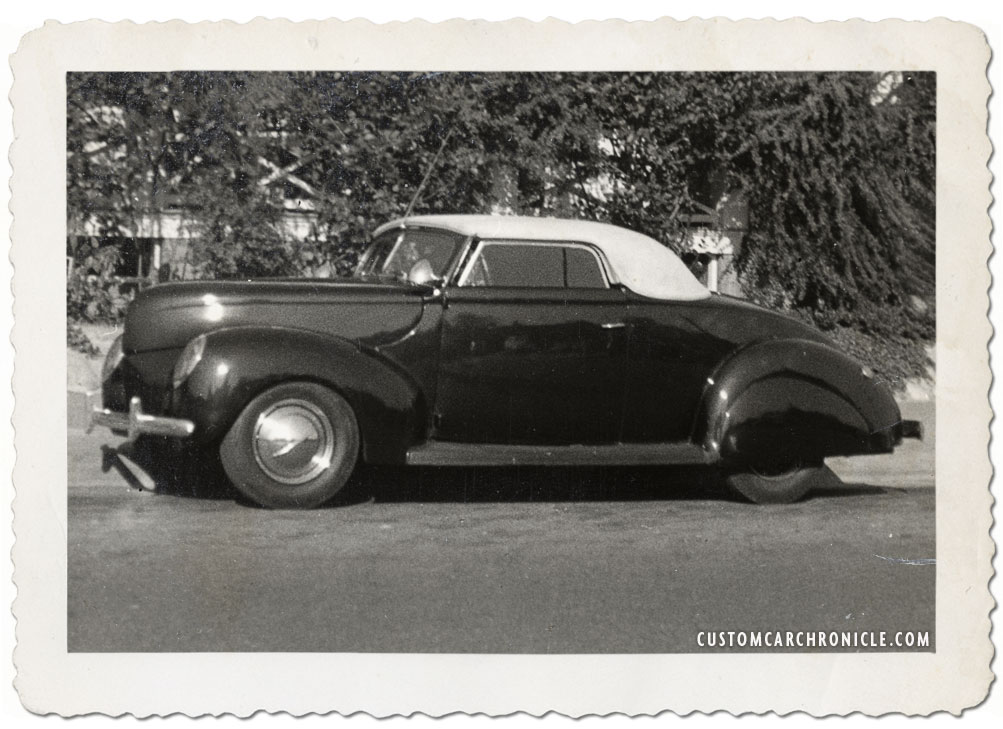 Photo taken around 1943 shows a typical for that era restyled 39 Ford Convertible with chopped windshield and padded top, teardrop bubble skirts, aftermarket grille filler piece and small diameter flipper hubcaps with beauty rings on black wall tires. Typical WWII era custom.
Photo taken around 1943 shows a typical for that era restyled 39 Ford Convertible with chopped windshield and padded top, teardrop bubble skirts, aftermarket grille filler piece and small diameter flipper hubcaps with beauty rings on black wall tires. Typical WWII era custom.
[divider]
The Custom Cars built during WWII and shortly after the war was over had a very distinctive look, the black tired and mostly dark paint made the cars look a bit evil, aggressive, powerful, and bolt, a little less elegant than the same car with a set of white wall tires mounted. It is a look that was not created on purpose, it came about due to the restriction. But it sure is a look that very distinctive for the early to mid 1940’s American Custom Car, and it has been a look that is more and more desired by a group of early Custom Car enthusiasts today.
 From the Bill Gaylord personal album comes this early 1940’s photo showing a nicely restyled ’40 Mercury with a rather high stance, especially in the rear. The car has one of Bill’s padded tops and looks rather bold with the tall black wall tires.
From the Bill Gaylord personal album comes this early 1940’s photo showing a nicely restyled ’40 Mercury with a rather high stance, especially in the rear. The car has one of Bill’s padded tops and looks rather bold with the tall black wall tires.
[divider]
 Even this Custom 1941 Cadillac convertible used black wall tires in the early 1940’s.
Even this Custom 1941 Cadillac convertible used black wall tires in the early 1940’s.
[divider]
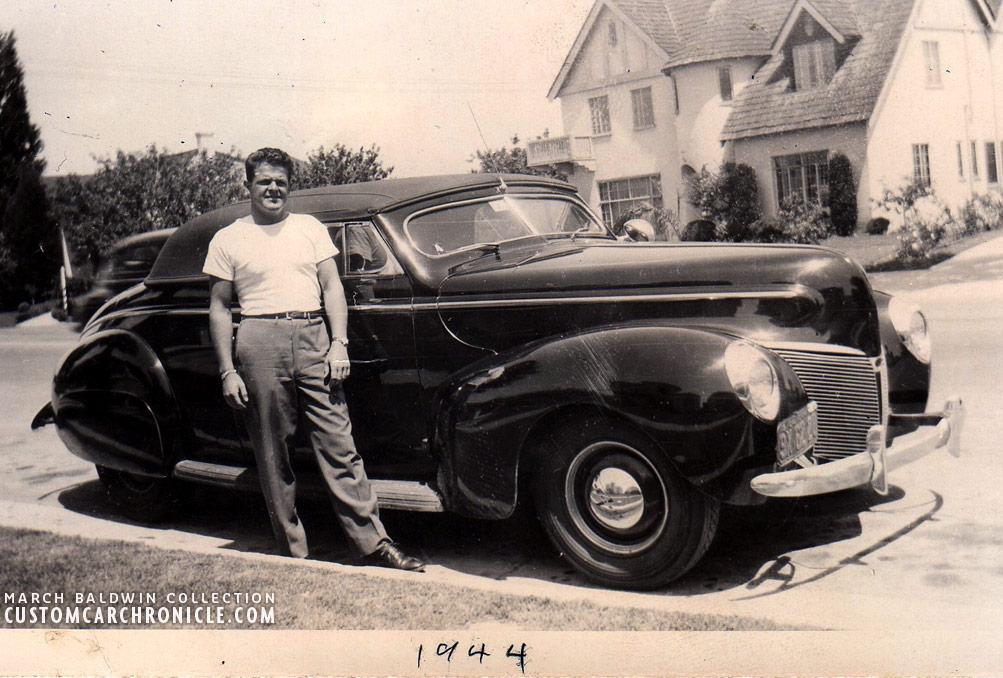 Early 1940’s style at its best. Dark painted chopped 1940 Mercury with a dark colored padded top, rather high stance, black wall tired and small diameter smooth moon hubcaps. The photo is marked 1944, but judging the license plate it was most likely taken earlier than that.
Early 1940’s style at its best. Dark painted chopped 1940 Mercury with a dark colored padded top, rather high stance, black wall tired and small diameter smooth moon hubcaps. The photo is marked 1944, but judging the license plate it was most likely taken earlier than that.
[divider]
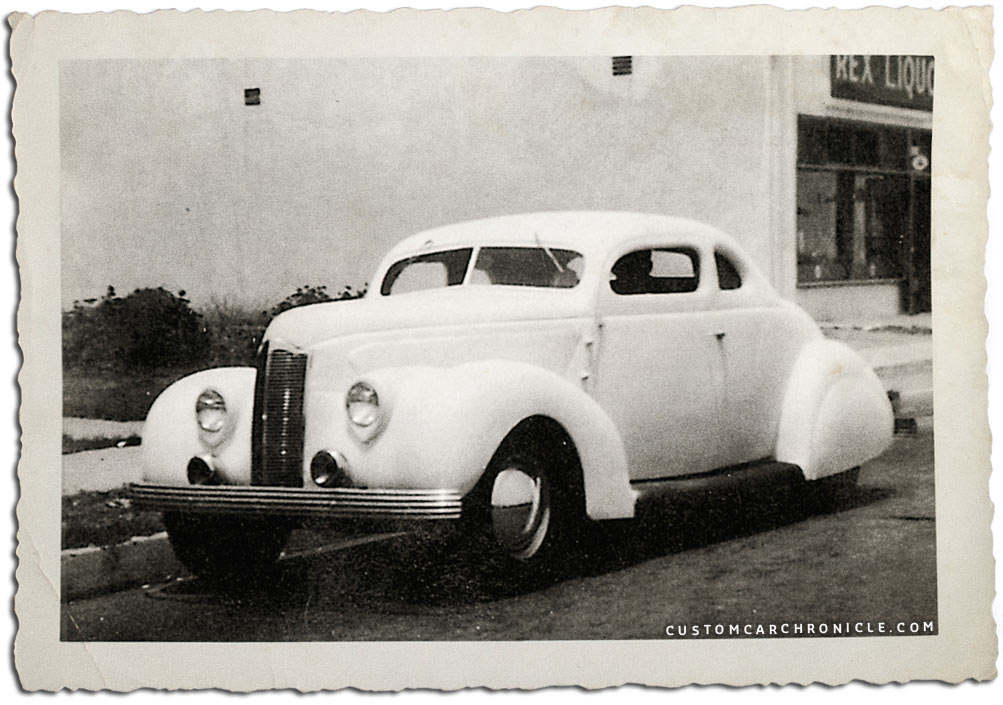 Famous early Barris custom with black wall tires with a wonderful sinister look was Dick Fowler’s 1938 Ford. Large diameter single bar flipper hubcap and beauty ring gave this was just the right balance combined with the black wall tires.
Famous early Barris custom with black wall tires with a wonderful sinister look was Dick Fowler’s 1938 Ford. Large diameter single bar flipper hubcap and beauty ring gave this was just the right balance combined with the black wall tires.
[divider]
 1945 photo shows a mildly restyled 1940 Mercury convertible with Buick skirts, once again single bar flipper hubcaps and black wall tires. The black wall tires sure made the cars look to sit lower than the white wall tires. Which was a big plus.
1945 photo shows a mildly restyled 1940 Mercury convertible with Buick skirts, once again single bar flipper hubcaps and black wall tires. The black wall tires sure made the cars look to sit lower than the white wall tires. Which was a big plus.
[divider]
 Even George Barris had to use black wall tires on his 1941 Buick custom. The Barris Shop even put out an ad in an early Hot Rod magazine using a photo of the Buick wearing black wall tires.
Even George Barris had to use black wall tires on his 1941 Buick custom. The Barris Shop even put out an ad in an early Hot Rod magazine using a photo of the Buick wearing black wall tires.
[divider]
 Harry Westergard also had to dress his cars with black wall tires during WWII as this photo of max Vernis’s 36 Ford Roadster from around 1943 shows.
Harry Westergard also had to dress his cars with black wall tires during WWII as this photo of max Vernis’s 36 Ford Roadster from around 1943 shows.
[divider]
 Ed Jenson took a picture of this mildly restyled 38-39 Ford around 1944. This set up shows that tires were become harder and harder to find. The fronts are regular black wall tires, but the rear are tall winter tires, far from elegant.
Ed Jenson took a picture of this mildly restyled 38-39 Ford around 1944. This set up shows that tires were become harder and harder to find. The fronts are regular black wall tires, but the rear are tall winter tires, far from elegant.
[divider]
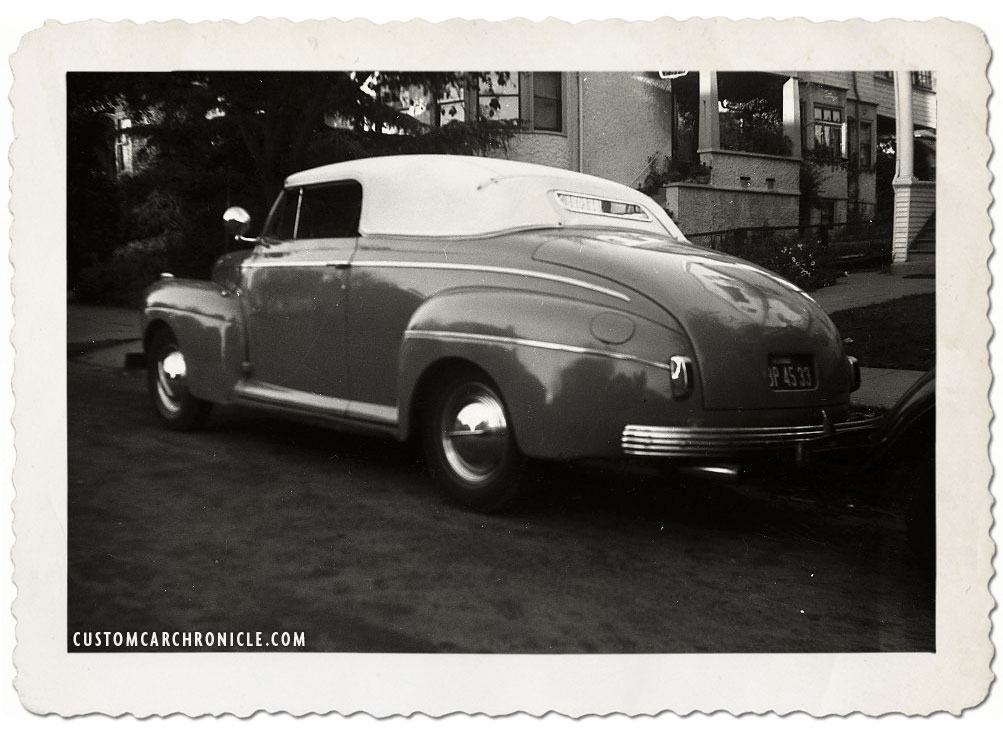 1945 photo of an 1941 Ford convertible with chopped padded top, single bar flipper hubcaps, 37 DeSoto bumper and black wall tires. It shows that the metal customizing parts were still available, but no white wall tires yet.
1945 photo of an 1941 Ford convertible with chopped padded top, single bar flipper hubcaps, 37 DeSoto bumper and black wall tires. It shows that the metal customizing parts were still available, but no white wall tires yet.
[divider]
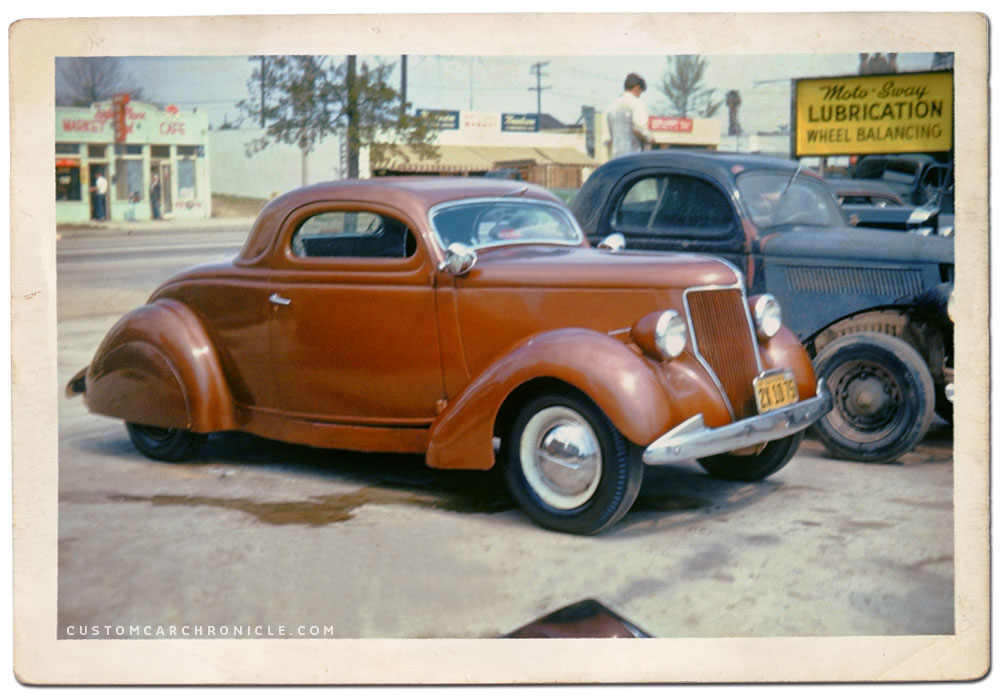 Lynn Jakel’s 1936 Ford used black wall tires and some sort of white painted wide trim rings in 1948. The white wall tires must still be hard to find, or to expensive for some.
Lynn Jakel’s 1936 Ford used black wall tires and some sort of white painted wide trim rings in 1948. The white wall tires must still be hard to find, or to expensive for some.
[divider]
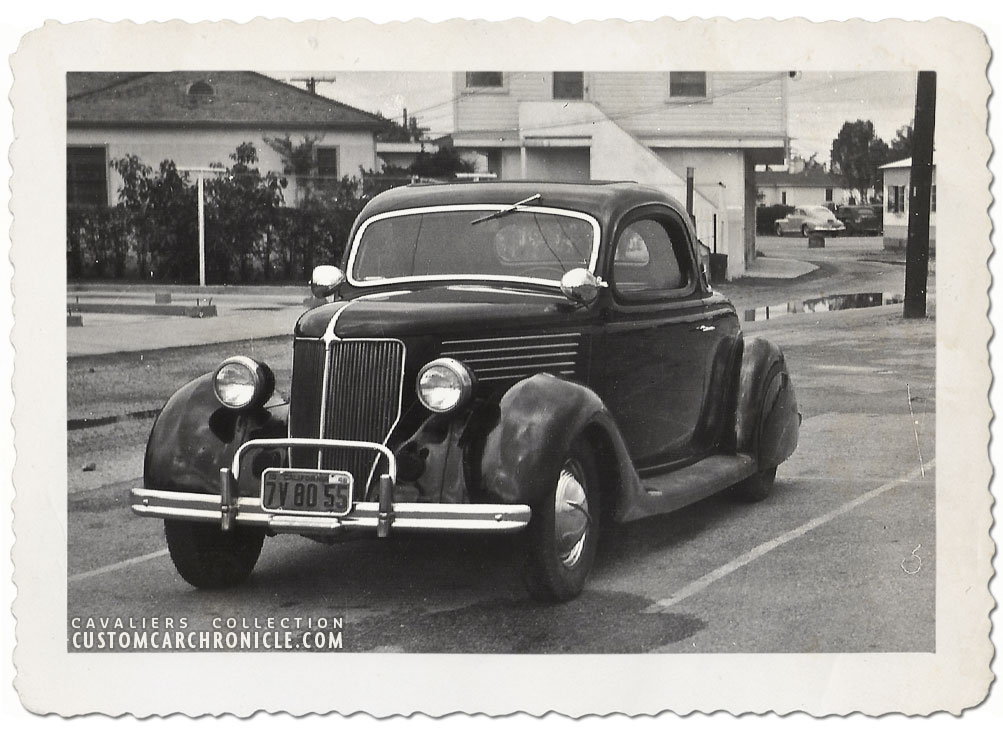 This Cavalier’s (Long Beach) ’36 Ford Custom Coupe was photographed around 1948, still wearing black wall tires.
This Cavalier’s (Long Beach) ’36 Ford Custom Coupe was photographed around 1948, still wearing black wall tires.
[divider]
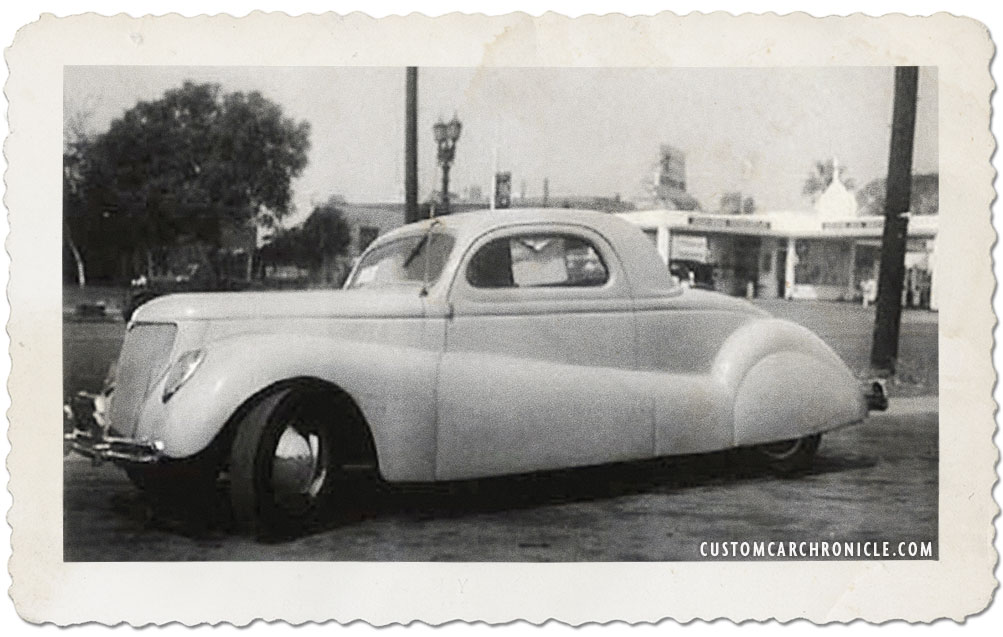 Jimmy Summers created this full custom ‘1936 Ford coupe with chopped top and full fade away fenders in the early 1940’s together with shop employee Bob Fairman. This photo was taken around 1946.
Jimmy Summers created this full custom ‘1936 Ford coupe with chopped top and full fade away fenders in the early 1940’s together with shop employee Bob Fairman. This photo was taken around 1946.
[divider]
 Wally Welch looking tough with his sinister looking black ’39 Chevy coupe with black wall tires and single bar flipper hubcaps.
Wally Welch looking tough with his sinister looking black ’39 Chevy coupe with black wall tires and single bar flipper hubcaps.
[divider]
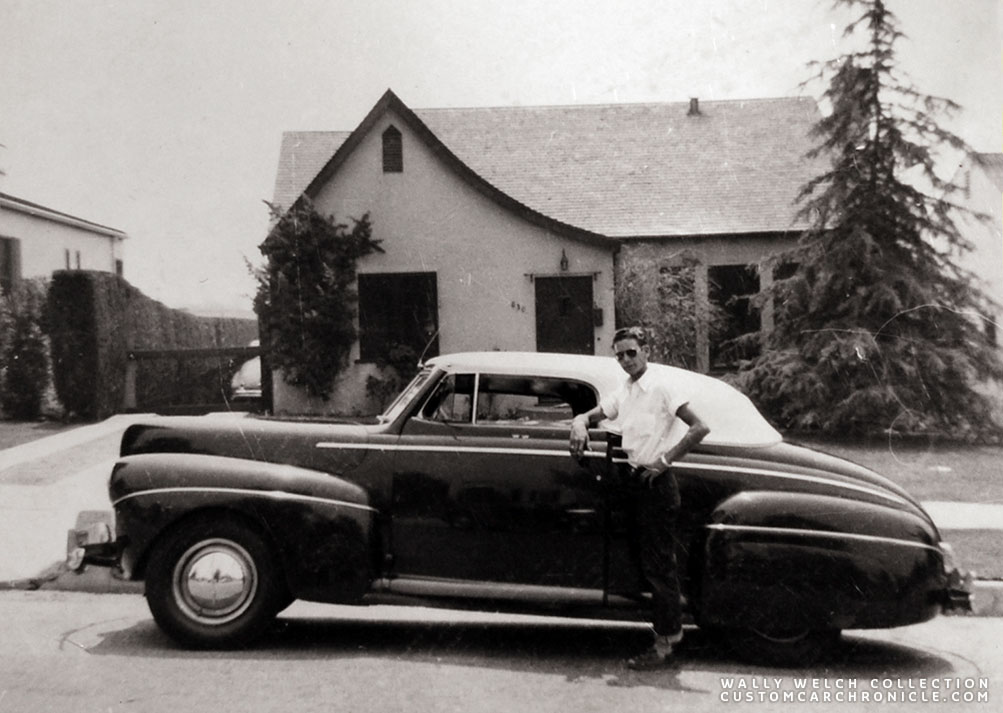 Wally Welch had the Ayala’s do his ’41 Ford around 1947, he had to use black wall tires in the beginning as well. Later he updated the car with a set of white wall tires which changed the looks to a much more classic restyled custom, as you can see on the image below.
Wally Welch had the Ayala’s do his ’41 Ford around 1947, he had to use black wall tires in the beginning as well. Later he updated the car with a set of white wall tires which changed the looks to a much more classic restyled custom, as you can see on the image below.
[divider]
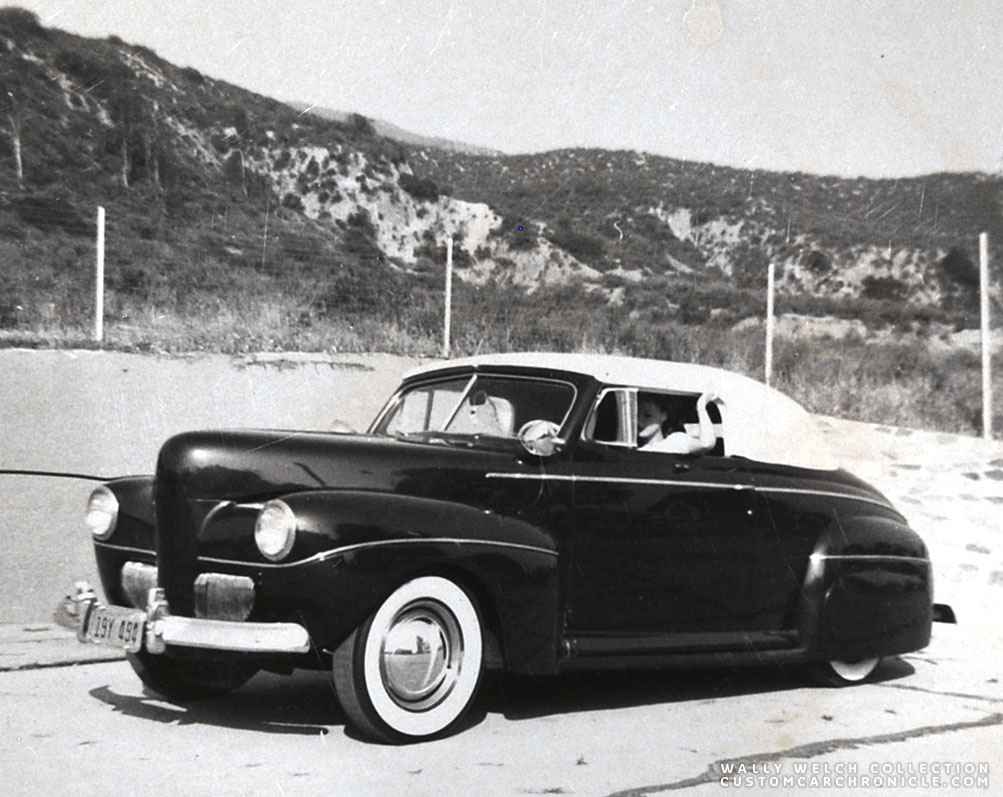 The Wally Welch ’41 Ford now with a set of white wall tires. They changed the look of the car completely.
The Wally Welch ’41 Ford now with a set of white wall tires. They changed the look of the car completely.
[divider]
Black and white
There are also a lot of samples showing custom cars with a set of white wall tires on the front, and black wall tires on the back. Most of the rear tires were covered by fender skirts on these samples, but is still is very evident they use only two white all tires on the car. In 1946 the production of the white wall tires was resumed, but it took a while to build up sufficient stock, and since they were rare, they most likely were also more expensive that they used to be before the war. This made it hard for the young custom car enthusiast to get a set of four for their ride.
 Jimmy Summers used a set of then very rare white wall tires on the front of his freshly finished 1940 Mercury in 1946. But on the rear he was forced to use far less attractive black wall tires. As soon as more white wall tires became available Jimmy would add them to the rear as well.
Jimmy Summers used a set of then very rare white wall tires on the front of his freshly finished 1940 Mercury in 1946. But on the rear he was forced to use far less attractive black wall tires. As soon as more white wall tires became available Jimmy would add them to the rear as well.
[divider]
 Another sample of the combination of white walls on the front and black walls on the rear is this ’36 Ford coupe photographed around 1945.
Another sample of the combination of white walls on the front and black walls on the rear is this ’36 Ford coupe photographed around 1945.
[divider]
Alternatives
During the time the white wall tires could not be produced several companies came up with alternative products. But none of them had the same effect or were as durable as the original white wall tire. Calnevar, and several others came up with white painted smooth beauty rings that were so wide they even covered the full wheels. These, Calnevar called them Whitesides, looked nice, but still the effect was not much different than a chrome hubcap and beauty ring. Several car companies, including Buick offered similar products as for their customers.
An other product was the so called “Porta-Walls” rings of soft white synthetic rubber imitating white wall sides. they could be fitted inside the wheel and tire and best be glued to the black wall tires. But they never lasted long back then. The glue was not holding up very well, and the “poor” quality tires made sure the walls would fit loose or even fly off soon after installation. And then there was White Wall Paint. Western Auto or Pep Boys and possibly other sources offered this cheaper alternative. You just brushed it onto your black wall tire and it looked pretty decent if you did a good job with a steady hand… from a few feet away. So basically there were no good alternatives to the white wall tire, hence the widely use of black wall tires on customs during the early to mid 1940’s.
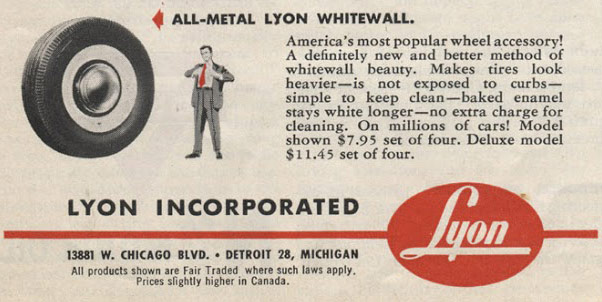
[divider]
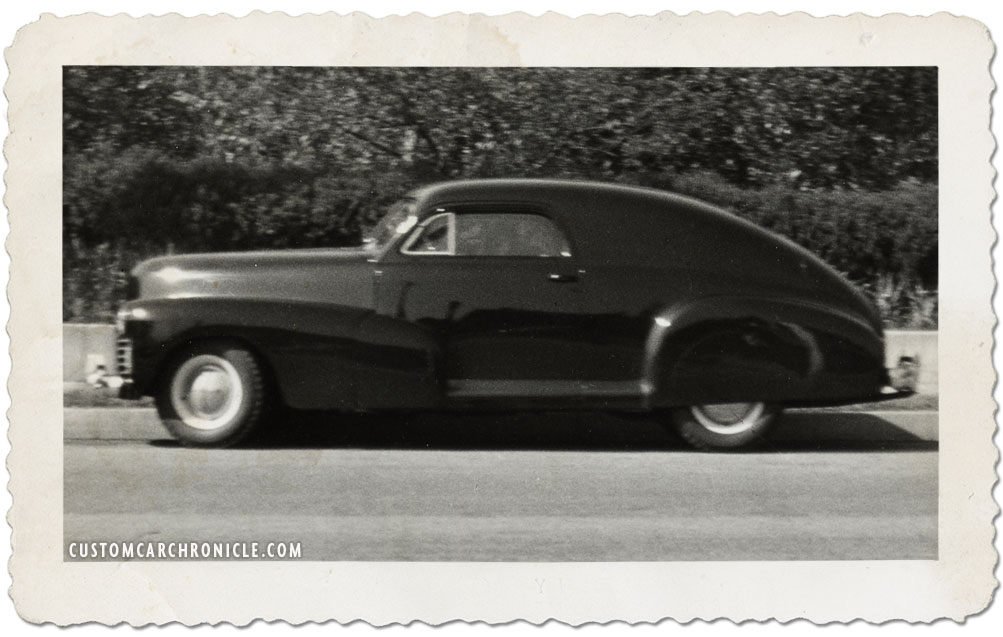 Marvin Lee’s 1942 Chevy with filled in rear quarter windows is a good sample of how the Calnever (or similar) Whitesides worked on the car. They did give the sides some more contrast and made the wheels looks slightly taller, but nowhere near the effect of a real white wall tire.
Marvin Lee’s 1942 Chevy with filled in rear quarter windows is a good sample of how the Calnever (or similar) Whitesides worked on the car. They did give the sides some more contrast and made the wheels looks slightly taller, but nowhere near the effect of a real white wall tire.
[divider]
 Ron Brooks shared this photo of Hank Ramsey’s 1941 Chevy convertible with chopped Hall top. It is a great sample showing the use of the white wall dress up rings.
Ron Brooks shared this photo of Hank Ramsey’s 1941 Chevy convertible with chopped Hall top. It is a great sample showing the use of the white wall dress up rings.
[divider]
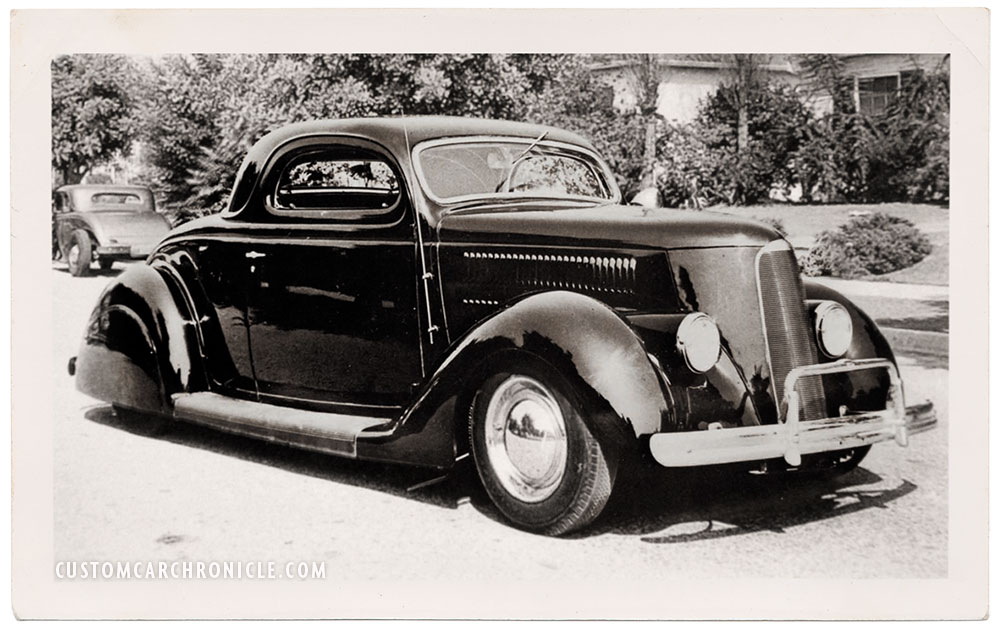 There also were exceptions… Jack Calori the owner of the world famous 1936 Ford coupe “hated” white wall tires, so his Custom Coupe was set up with black wall tires in the later part of the 1940’s when the car was finished. And the car would never see any white wall tires for as long as Jack was the owner.
There also were exceptions… Jack Calori the owner of the world famous 1936 Ford coupe “hated” white wall tires, so his Custom Coupe was set up with black wall tires in the later part of the 1940’s when the car was finished. And the car would never see any white wall tires for as long as Jack was the owner.
[divider]
 In February 1951 the white wall tires were banned once again. This time to benefit the Korean war. But this time the effect was much less visible. The early 1950’s was partof the Golden Years of Customizing and many great customs cars were creating during this time, most of them, if not all had white wall tires.
In February 1951 the white wall tires were banned once again. This time to benefit the Korean war. But this time the effect was much less visible. The early 1950’s was partof the Golden Years of Customizing and many great customs cars were creating during this time, most of them, if not all had white wall tires.
[divider]
 Similar tires (not exactly the same) show the huge difference in effect of the all black tire or the one with the white wall insert.
Similar tires (not exactly the same) show the huge difference in effect of the all black tire or the one with the white wall insert.
[divider]
 Black wall tire with black wheel and single bar flipper hubcap with ribbed beauty ring on the Barris Customs created 1938 Ford Coupe for Dick Fowler. Photo taken of the partly restored car at the 2011 GNRS Customs Then & Now exhibit.
Black wall tire with black wheel and single bar flipper hubcap with ribbed beauty ring on the Barris Customs created 1938 Ford Coupe for Dick Fowler. Photo taken of the partly restored car at the 2011 GNRS Customs Then & Now exhibit.
[divider]
 Dave Conrad’s beautiful mildly chopped ’36 Ford Coupe uses aftermarket Cadillac style hubcaps with black wall tires for that mid 1940’s look and feel.
Dave Conrad’s beautiful mildly chopped ’36 Ford Coupe uses aftermarket Cadillac style hubcaps with black wall tires for that mid 1940’s look and feel.
[divider]
(Special thanks to Wikipedia and www.sarahsundin.com)
![]()




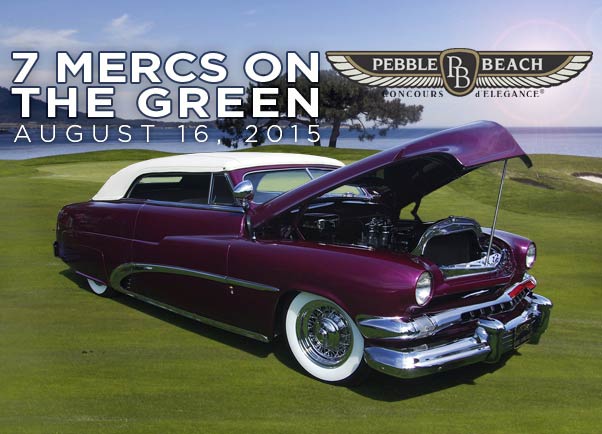

More interesting research to ponder. I enjoy these “history lessons” very much. Thanks Rik!
Dave
Another well-written article! A lot of kustoms look fantastic with basic blackwalls…more sinister looking.
Thanks for the history lesson, very interesting!
Thanks for your research into the whys of what we see in tires for the different eras of custom cars, Gasoline was rationed, coupes were turned into “utes” and tires were precious, hard to come by for sure during the War years. Later, on my 52 Chevy, I ordered a set of “PortaWalls” from Warshawsky’s (Now J.C.Whitney’s) out of Chicago. A real poser,didn’t fool anyone, but wanted that look that I couldn’t afford.
im a believer white walls makes the kustom cars just me, i could not afford white walls so id go to western auto or pep boys an buy there white wall tire paint presto i had me white walls tires, sure liked this story rik,
Very interesting article Rik thanks!
Wow , Rik , another sought after answers on this subject , I never liked blackwalls on a custom , looks to plain , but that’s me ! On the other hand to recreate a custom with the conditions that was present at that time Im all for it . Great spotting two customs that only had whitewalls in the front !!
Again and again , big thanks for this in depth article in the obscure for us that eat and breath this stuff !
Wolf
Good history lesson but I’ve never seen a Kustom that didn’t look better with whitewalls.
I just ordered my white walls for my 55 Belair .
Can’t wait for my G78’s for that look!!
Good article.
Great article Rik. I am honored to have a picture of my ’36 in it. I think most Custom Cars should have whitewall , and some shouldn’t.